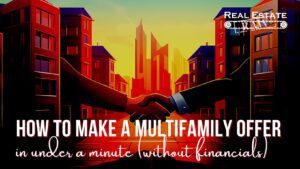I am making the unfortunate prediction that there will be a wave of foreclosures, in larger (20-200 unit) and older multifamily apartment complexes, over the next 1-5 years.
Multifamily buildings built between 1955-1980 are beginning to see the end of their expected life span for the interior systems of the buildings. Plumbing, electrical, sub-flooring, parking are just a few examples of areas that are beginning to run up unexpected (and unbudgeted) costs for owners of these older buildings.
Why not just fix it?
The issue here is what is called Cost Basis. Simply put, cost basis is what something costs plus any money invested in it. In a multifamily asset the cost basis would be the purchase price, plus any down payment money, closing costs and any cost of capital expense improvements (fixing crap that breaks).
The general financing and analysis of a deal is straight forward and easy to calculate.
Income – Expenses = Net Operating Income (NOI)
NOI – Debt Service (mortgage payment) = Cash Flow
Typically, the value of a multifamily asset is valued on the amount of net positive cash flow it can create. The more cash flow to the investors/buyers… the more valuable the building. Easy to understand.
What is the value of the building if it is not currently cash flowing? What is the value of a building if it will never cash flow again?
This may be the case as buildings age combined with the global cost of goods increase (not to mention any supply chain issues). As the cost to refurbish the building increases…so does the cost basis. If the cost to refurbish the building outpaces the general appreciation of the building (location, location, location) then you will have a cost basis that is greater than the after-repair value (ARV). Now you have this formula-
(If) Cost Basis > ARV = Foreclosure
Simply put, if the property costs more money than it makes, it will be hard to make the mortgage payments. Or if you do make the mortgage payments, it will be out of your personal income. How long will that last? This concept will be applicable for all owner types, from mom-and-pop owners to large institutional owners (REITS etc.)
As the America ages so does its infrastructure. This is not a problem technically. Money solves all the issues. The problem comes when there is no PROFIT in solving those issues. Who will do it then? Who will pay for it? You?
We have already begun to see this issue rear its ugly head recently. Three examples are the massive water crisis in Flint, Michigan resulting in lead being leached into drinking water due to old lead lined pipes and a chemical issue at the treatment plant. The residents of Jackson, Mississippi have also experienced a similar issue due to an aging water treatment facility and flooding. The Surfside condominium collapse in Miami stands as one of the most tragic and current examples of failed infrastructure.
The solution to the problem is obviously simple. Just spend a lot of money and fix all the problems. Easy. Right?
Only the U.S. Government can print money just for the fun of it. The rest of us are subject to the laws of finance. Basically stated… you don’t spend money unless you are going to make money. This is why it is called real estate investing not real estate charitable donating. Were all here to make money and if a property may not make money, because the cost to fix it is greater than the potential profit…that’s bad.
My overall concern (and prediction) is that some owner/operators of these aging buildings will not be able to make the necessary repairs and make the monthly debt service payments. At this point these owners may choose to allow the property to go into foreclosure.
A second issue with the age of these building will come into play when many of these owners attempt to exit the deal by selling or refinancing. Most lenders traditionally stick to a 1.2+ debt service coverage ratio (DSCR) when underwriting a loan application.
DSCR = NOI / Annual Debt Payment
As interest rates rise and remain elevated, this tends to lower the DSCR for most deals. The answer is to lower the amount of debt (lower LTV) or to lower the price. Either will raise a DSCR calculation. The higher the interest rates the lower the DSCR (or price or LTV). Now add in the cost for the needed repairs to fix all the differed maintenance that the last 5 owners, in a row, neglected to do and… the DSCR plummets. The answer- pay less or borrow less.
Insurance is also an unsung villain in our story. The insurance industry is already facing serious headwinds as global weather patterns become more destructive (pun intended). The rising damages due to weather related incidents is driving up the cost of insurance, but I think that it will pale in comparison to the damage older buildings will do to the cost of new polices. Older assets will simply become very expensive to insure or uninsurable at all. No insurance… no loan.
Conclusion-
A lot of older assets have been overvalued in the last 5-7 years and may see a large reset in valuations due to the overall cost of repairs and high interest rates.
Debt and insurance will be harder to get for these aging assets.
The values will decline, and some loans will default.
Solution-
If you own older buildings, start planning an exit strategy now. Don’t delay capital improvements in favor of cash flow if, the breakdown of that system will impede normal business. What I mean here is don’t make cash flow distributions if the system (plumbing, electrical etc.) could collapse and shut down your ability to run the property at all. This would also have a very negative effect on your exit.
Note- It has been my personal experience that city code enforcement officers don’t have much of a sense of humor when all your tenants are standing in the apartment parking lot, with no running water, on a hot afternoon, while raw sewage flows into the creek behind your building (true story).
Refinance now and lock in a long-term loan if you can’t sell. If you can sell…, do it! If you are looking to buy residential real estate, I strongly suggest you pay close attention to the age and hidden repairs of an older building. If you find needed repairs, take it off the purchase price.
The last solution will be the use of creative financing to solve problems. If a seller has a distressed asset, you need to get them to join you in the risk of solving their problems. You didn’t put them in the situation they are in, but you can help them get out, if they will let you.
Create problem solving offers that create value for the seller first, the property next, and lastly…you. This is what I call the S.P.Y technique and is fully discussed in my book Creative Cash.
Look for sellers with problems and find ways to solve them to create opportunities to build a portfolio in this new market environment.


































